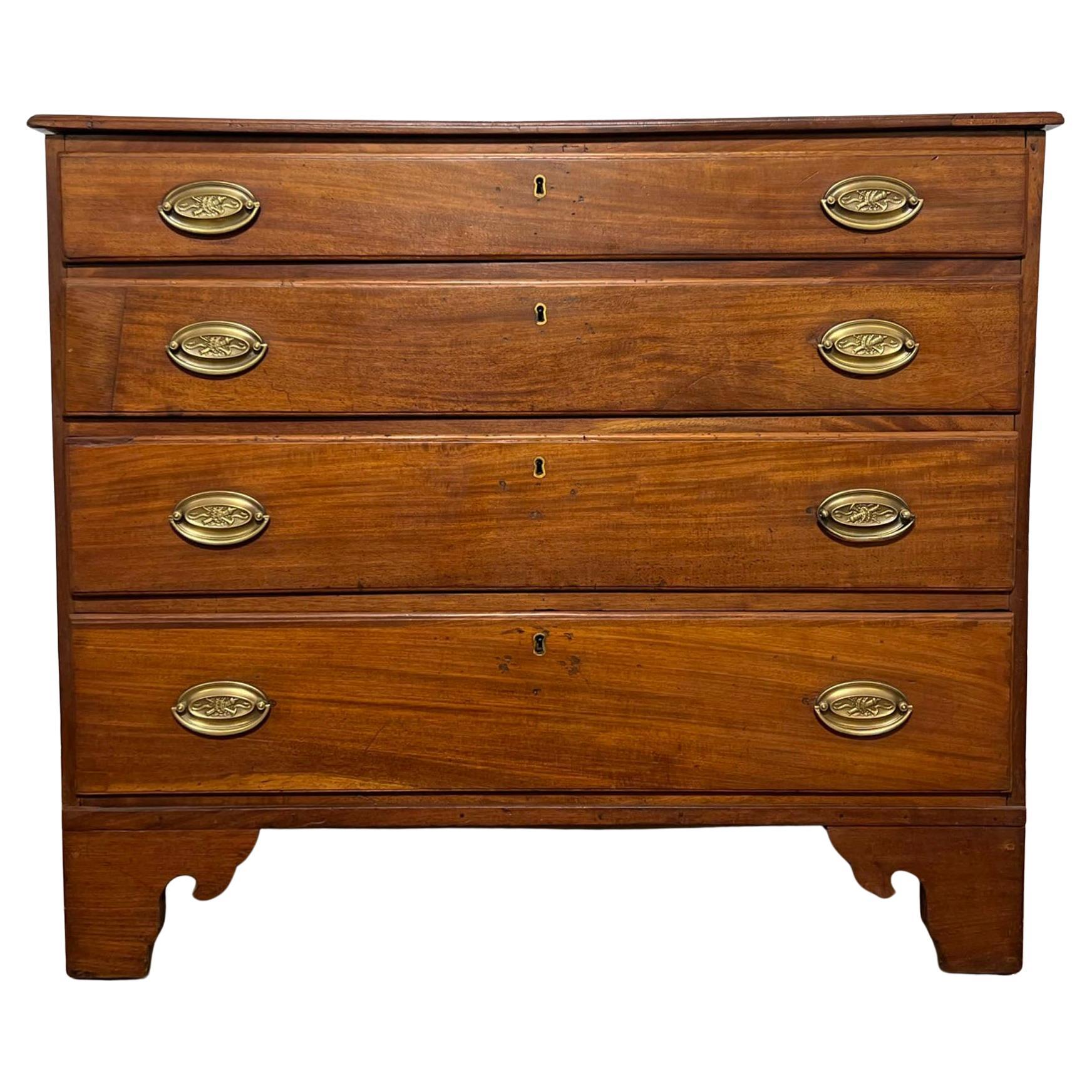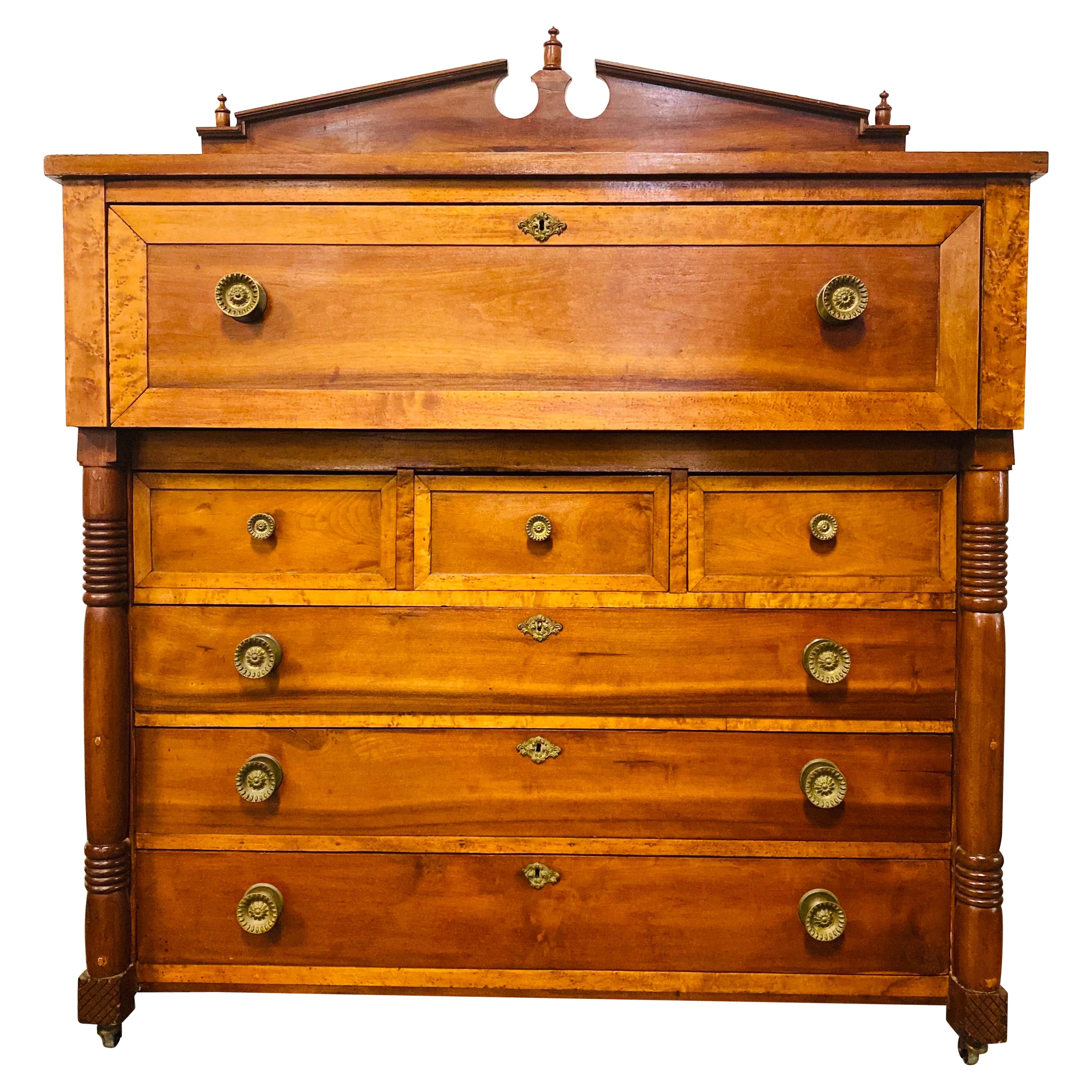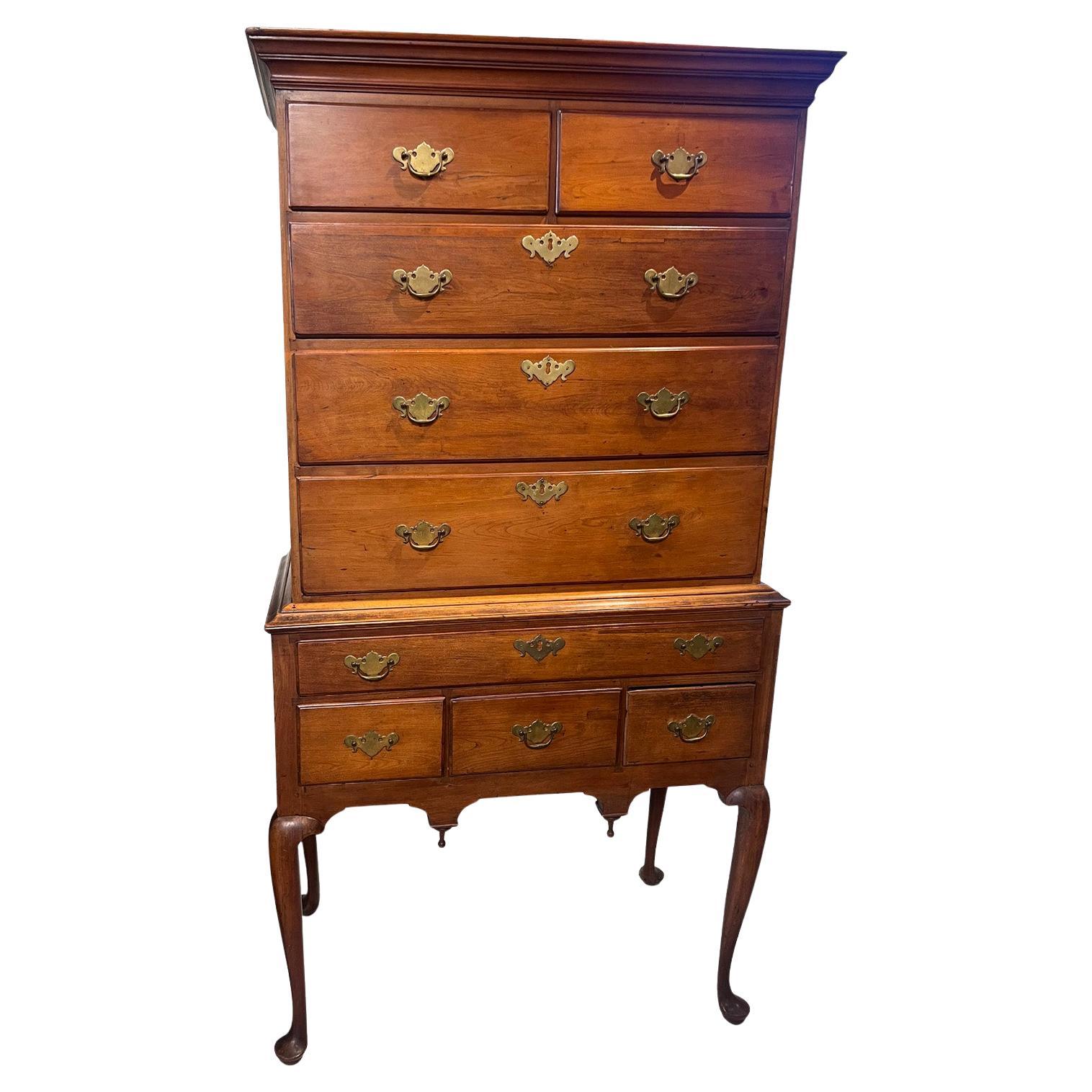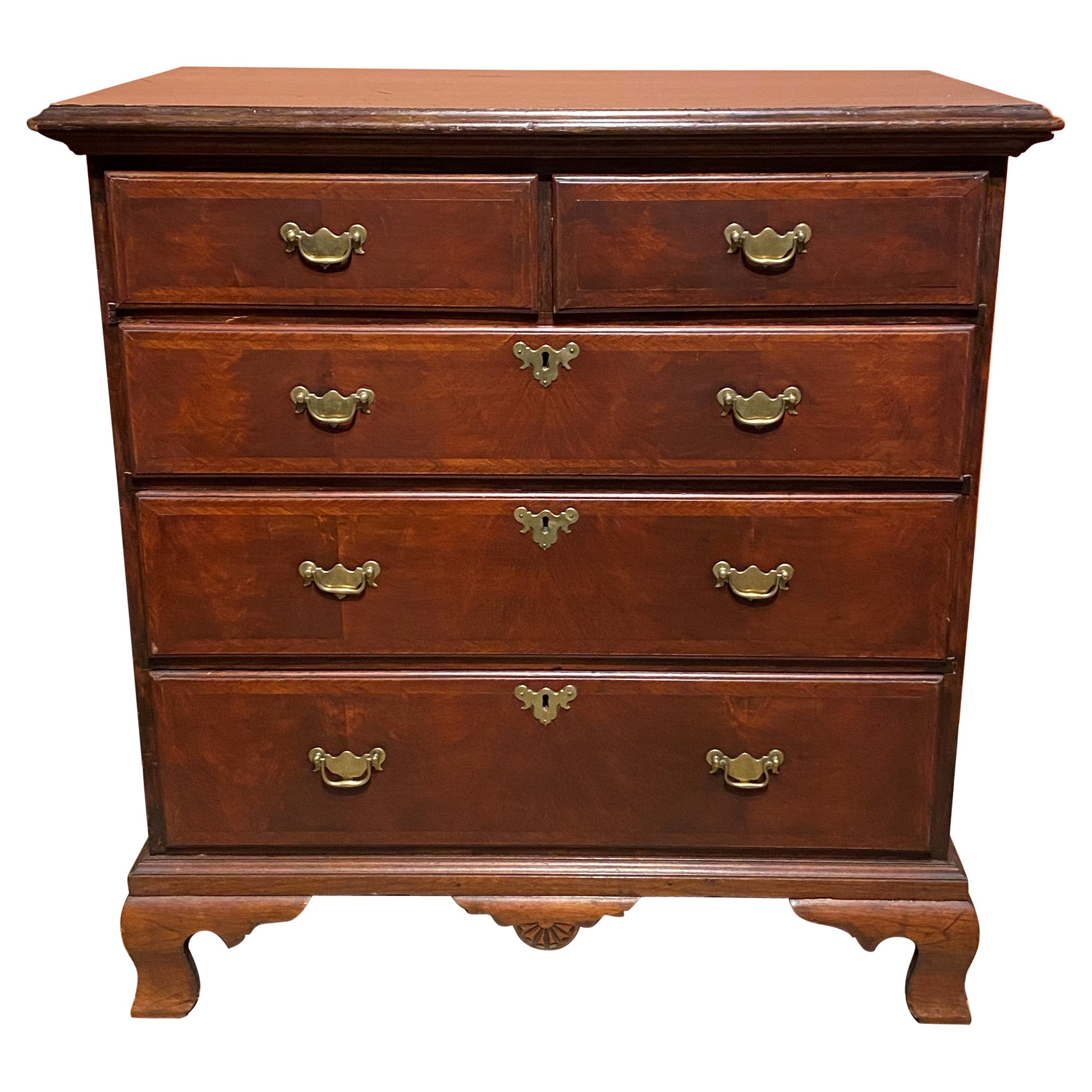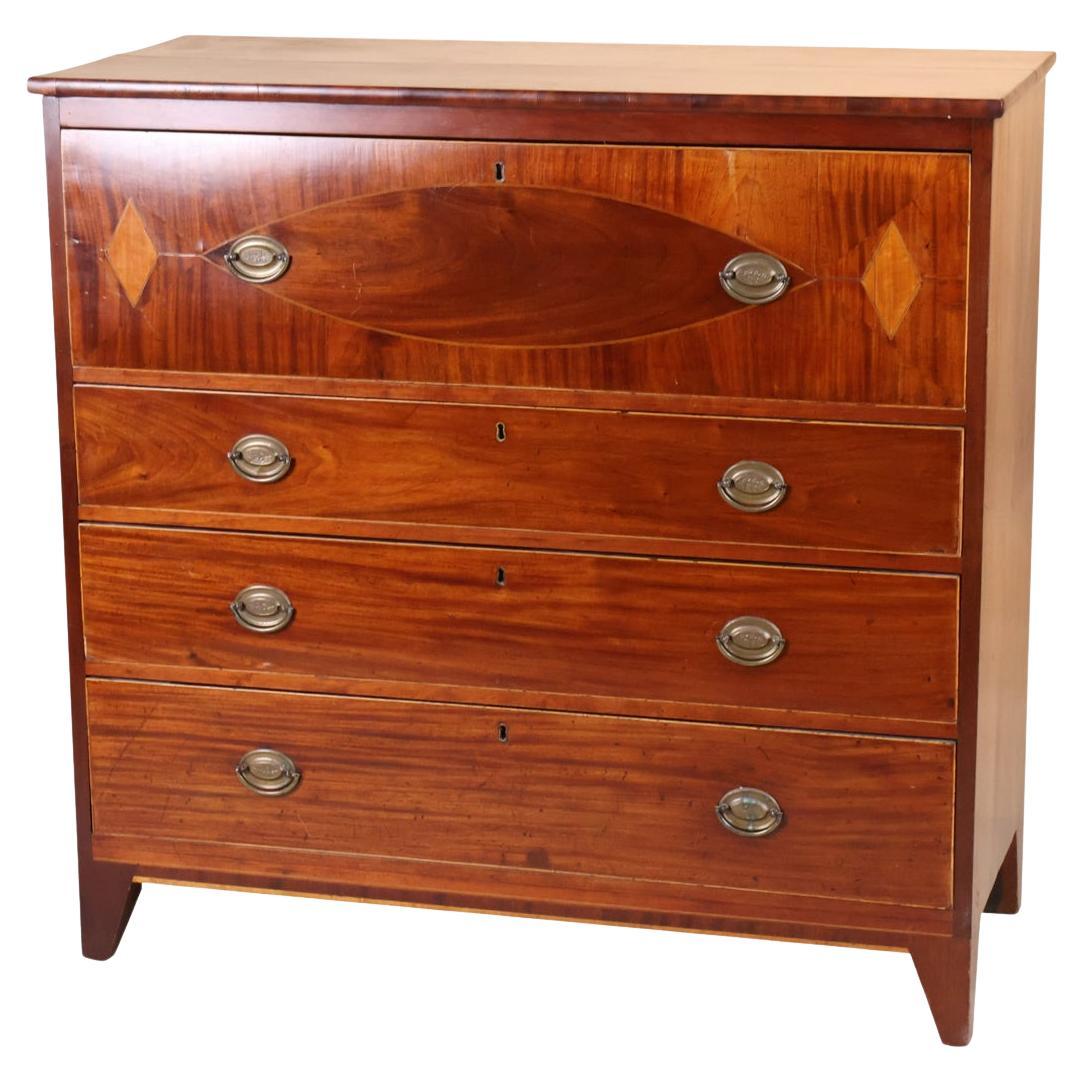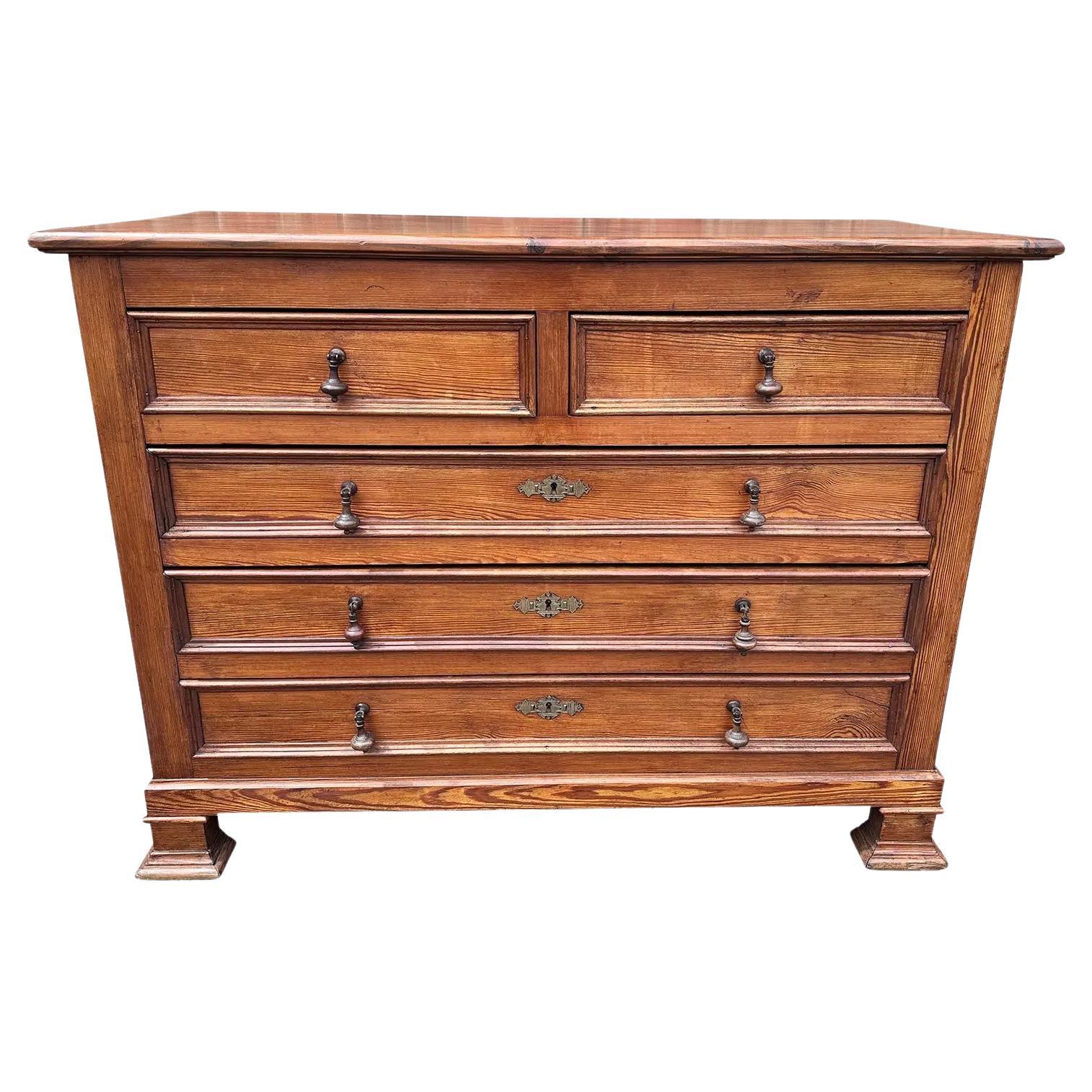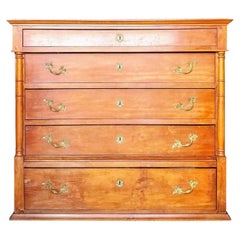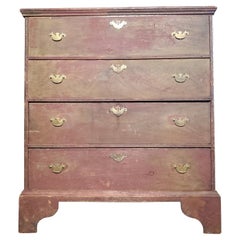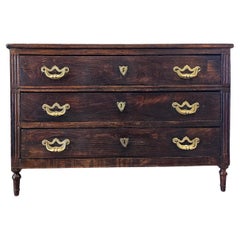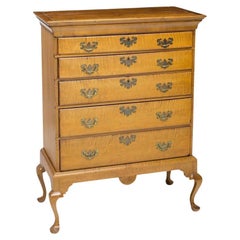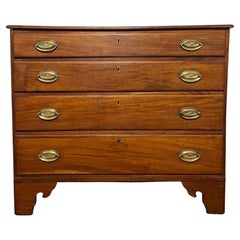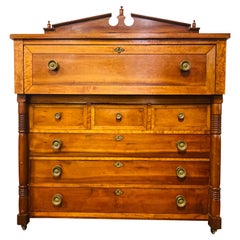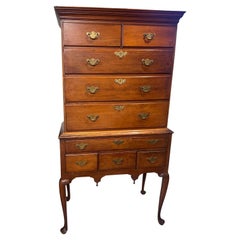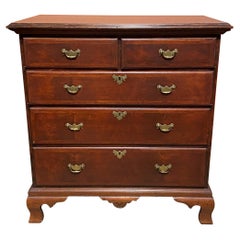Items Similar to 19th Century Tennessee American Classical Jackson Press
Want more images or videos?
Request additional images or videos from the seller
1 of 11
19th Century Tennessee American Classical Jackson Press
$5,500
£4,147.55
€4,796.84
CA$7,716.47
A$8,577.34
CHF 4,496.06
MX$104,750.03
NOK 56,130.66
SEK 52,808.48
DKK 35,802.19
About the Item
A scarce American Classical cherrywood Jackson Press with beautifully aged mellow patina, dating to the first half of the 19th century.
Born in Tennessee, most likely the eastern region of the state, circa 1830-1850, hand-crafted of warm, rich solid Cherrywood, with Southern Pine and Poplar secondary woods, having a rectangular top, over conforming well made case fitted with four graduated drawers. Featuring a projecting or stepped top drawer, hand-cut dovetail joinery throughout, band inlaid drawer fronts adorned with original wooden knobs, flanked by turned colonette pilasters, recessed paneled sides, rising on turned feet.
DIMENSIONS: (approx)
46" High, 43" Wide, 23.5" Deep
As warm and attractive as it is useful, having the ideal large size and proportions for a variety of different uses, including as a chest of drawers commode or dresser, sideboard server buffet, credenza, oversized hall console, and more.
HISTORY:
Although Tennessee furniture has been an overlooked and forgotten treasure, the simple and straightforward functional pieces produced by Tennessee craftsmen before 1850 reflect an era of outstanding craftsmanship. The furniture of this period exhibits dignity and worth of material objects from everyday life.
The distinguishing characteristics of the grain and color of cherry made it the favored wood for early Tennessee cabinetmakers and furniture makers. Tulip-poplar was used in pieces made throughout the state, but Southern yellow pine was used in the geographic regions of higher altitudes where these trees were plentiful.
Early furniture-making was not limited to cabinetmakers in major settlements like Greeneville, Knoxville, Memphis, and Nashville, where the average shop operated with no more than three craftsmen. Many craftsmen lived in rural country areas and combined their craft with farming and carpentry. Other craftsmen, such as turners, joiners, chairmakers, carpenters, upholsterers–produced furniture for Tennessee homes. For cabinetmakers and related craftsmen, the growing towns offered more opportunities for successful businesses.
Nineteenth-century craftsmen had to be versatile in order to survive, prosper, and satisfy the needs of their community. Rural and urban cabinetmakers served as a variety of needs, often including coffinmakers, which established them in the undertaking business. These craftsmen frequently adapted their skills to the needs of their patrons.
Tennessee furniture reflects the heritage of the westward migration and the individualism of the early pioneers. While isolated from eastern mainstream influences, frontier craftsmen inherited Old World craft traditions and often showed some familiarity with academic styles. Their work was also shaped, however, by their new environment and the peculiar circumstances and needs of a frontier society. The result was an individualistic combination of stylistic elements and an unconventional use of construction techniques that gave backcountry furniture the distinctive character so attractive to the collector and so challenging to the historian of material culture.
Identifying furniture made in Tennessee can be difficult, as cabinetmakers signed few pieces of furniture. Instead, artisans let style and craftsmanship identify their work. Many years later, this practice, while a testament to the craftsman's confidence in his distinctive style, is an impediment to those trying to identify the local region of the pieces.
Tennessee furniture has a simplicity in both form and decoration. Craftsmen of the region inlaid lighter woods into the native cherry and walnut for decorative appeal. The largest number of inlaid pieces originated in upper East Tennessee. The use of inlay declined in Middle Tennessee and is found least frequently in West Tennessee. Tulip-poplar was used in pieces made throughout the state, but yellow pine was used in the geographic regions of higher altitudes where these trees were plentiful.
The patrons of Tennessee furniture makers were primarily Anglo-Americans of English, Scots, and Scots-Irish descent. They arrived from Virginia, Maryland, and Pennsylvania, the products of diverse economic and social backgrounds. As they poured over the mountains, the settlers furnished their homes as their means allowed, using design concepts brought from eastern areas.
The difficulty of the journey to Tennessee often precluded the inclusion of furniture. As a consequence, settlers purchased locally made furniture after their arrival in the new region. As wagon roads became better and river shipping became easier, Tennessee craftsmen found themselves in competition with the skilled and stylistically sophisticated manufacturers in Pennsylvania, Virginia, and North Carolina. Cincinnati, one of the largest furniture manufacturing cities in the country, began shipping large assortments of furniture downriver to Tennessee. Prominent citizens like Andrew Jackson selected wares from Philadelphia, which were shipped upriver from New Orleans.
The most distinguishable Tennessee forms include the sugar chest and the Jackson press. The sugar chest was developed to safeguard large quantities of sugar, a commodity of great value. Fairly simple in design, a sugar chest consisted of a large wooden storage bin set on legs. The majority of chests featured a small drawer below the bin. Since only the most affluent nineteenth-century households could afford sugar in bulk, a sugar chest was a status symbol displayed in public areas of the home like the dining room.
The Jackson press is also indigenous to the Tennessee region. Although the form and name were contemporary with Andrew Jackson, the exact origins of the press remain unknown. As early as 1825 the term appeared in an estate inventory in Davidson County, where Andrew Jackson lived. Most presses consisted of a shaped back splash over a rectangular top above projecting drawers over cupboard doors set on turned feet.
In the small area of Good Spring, the Levi Cochran cabinet shop produced three Jackson presses between 1833 and 1835, charging from $20 to $23 for each.
The furniture produced in Tennessee during the nineteenth century imparts a sense of pride and respect for our forbearers who struggled to create homes of comfort and beauty in a new territory.
Derita Coleman Williams and Nathan Harsh, The Art and Mystery of Tennessee Furniture and Its Makers Through 1850 (1988)
PROVENANCE / ACQUISITION:
John Phifer Marrs collection.
Important auction house J. Garrett Auctioneers, Dallas, Texas, May 2021 catalog, presented a special curated collection from John Phifer Marrs, premier Southern interior designer known for an elegant, fresh and inviting design method, often called The New Southern Style.
John's work has been regularly featured in local and national publications including the venerable Architectural Digest, Traditional Home, and many others. He recently released his new book, Interiors for Collectors, and stays busy with both design work and author appearances.
CONDITION:
Great original antique condition. Beautifully aged patina lending to an elegant mellow warmth over the whole, worn smooth finish, with expected wear, including dark marks to the top and various antique character marks. Nothing that detracts from the aesthetics or functionality but only adds to the sophisticated elegance, rustic charm, and rich historical depth that can only be acquired over long periods of time.
- Dimensions:Height: 46 in (116.84 cm)Width: 43 in (109.22 cm)Depth: 23.5 in (59.69 cm)
- Style:American Classical (In the Style Of)
- Materials and Techniques:
- Place of Origin:
- Period:
- Date of Manufacture:circa 1830-1850
- Condition:Wear consistent with age and use. Minor losses. Minor fading. Great original antique condition. Beautifully aged patina lending to an elegant mellow warmth over the whole, worn smooth finish, with expected wear, including dark marks to the top and various antique character marks.
- Seller Location:Forney, TX
- Reference Number:1stDibs: LU5977229028392
About the Seller
4.8
Platinum Seller
Premium sellers with a 4.7+ rating and 24-hour response times
Established in 2013
1stDibs seller since 2021
295 sales on 1stDibs
Typical response time: <1 hour
- ShippingRetrieving quote...Shipping from: Forney, TX
- Return Policy
Authenticity Guarantee
In the unlikely event there’s an issue with an item’s authenticity, contact us within 1 year for a full refund. DetailsMoney-Back Guarantee
If your item is not as described, is damaged in transit, or does not arrive, contact us within 7 days for a full refund. Details24-Hour Cancellation
You have a 24-hour grace period in which to reconsider your purchase, with no questions asked.Vetted Professional Sellers
Our world-class sellers must adhere to strict standards for service and quality, maintaining the integrity of our listings.Price-Match Guarantee
If you find that a seller listed the same item for a lower price elsewhere, we’ll match it.Trusted Global Delivery
Our best-in-class carrier network provides specialized shipping options worldwide, including custom delivery.More From This Seller
View All19th Century Danish Chest of Drawers
Located in Forney, TX
A monumental Danish chest of drawers commode from the 19th century. The magnificent, handcrafted Scandinavian antique having molded cornice, over case fitted with five drawers, all w...
Category
Antique 19th Century Commodes and Chests of Drawers
Materials
Bronze, Ormolu
18th Century New England Country American Queen Anne Blanket Chest Of Drawers
Located in Forney, TX
A rare and most impressive early American Queen Anne style blanket chest, dating to the 18th century, found in New England, having a molded pine case fitted with rectangular iron pin-hinge top, opening to a deep storage compartment interior with faux drawer facing, over two lower drawers with hand cut dovetail joinery, rising on shaped bracket feet, early grain-paint over original red paint, adorned in later brass fittings, all enhanced by beautifully aged distressed original patina. circa 1750, Northeastern United States
Provenance / Acquisition:
O'Neill-Leonard Antiques...
Category
Antique 18th Century American Queen Anne Blanket Chests
Materials
Brass, Iron
Rustic 18th Century Italian Louis XVI Period Chest Of Drawers Commode
Located in Forney, TX
A handsome rustic antique Italian walnut chest of drawers commode. circa 1780
Hand-made in Italy in the second half of the 18th century, styled in Neoclassical inspired Louis XVI pe...
Category
Antique 18th Century Italian Louis XVI Commodes and Chests of Drawers
Materials
Brass
19th Century American Chippendale Style Curly Tiger Maple Highboy
Located in Forney, TX
An antique American Chippendale style curly maple (also called tiger or figured maple) chest on stand from the 19th century. This curly ma...
Category
Antique 19th Century American Chippendale Commodes and Chests of Drawers
Materials
Maple
19th Century Italian Bird’s-Eye Maple Chest of Drawers Commode
Located in Forney, TX
A stunning fine quality antique, circa 1860s/1870s Italian chest of drawers commode.
Hand-crafted in Italy in the third quarter of the 19th century, influenced by Napoleon III Se...
Category
Antique Mid-19th Century Italian Napoleon III Commodes and Chests of Dra...
Materials
Carrara Marble, Brass
Antique Italian Neoclassical Grisaille Paint Petite Chest Of Drawers Night Stand
Located in Forney, TX
Add a touch of refined elegance, understated sophistication, subtle luxury and cozy romantic warmth with this 200+ year old petite Italian commode, elevated by authentic beautifully ...
Category
Antique Late 18th Century Italian Neoclassical Commodes and Chests of Dr...
Materials
Bronze
You May Also Like
Antique Circa Early 19th Century American Federal Chest on Bracket Feet
Located in Peabody, MA
Antique American Federal period chest of four drawers in cherry over bracket feet.
Category
Antique Early 19th Century American Federal Commodes and Chests of Drawers
Materials
Brass
Handsome 19th century American Empire handcrafted Chester drawers
Located in Allentown, PA
This is a handsome late 19th century handcrafted American Empire chest of drawers. This chest of drawers features its original solid brass ornately decorated pulls and keyhole covers...
Category
Antique 1860s American American Empire Dressers
Materials
Wood
American Highboy Chest of Drawers
Located in Sag Harbor, NY
This is a special piece. Solid cherry wood exterior with solid poplar interior. Dowel construction on the entire casing. Each of the 9 drawers has dovetail construction on both the f...
Category
Antique Late 19th Century American American Colonial Commodes and Chests...
Materials
Cherry
18th Century American Two Over Three Chest of Drawers
Located in Milford, NH
A fine example of an 18th American chest of drawers in a two over three configuration, possibly a converted highboy top of Boston origin, with added finished molded top, original bra...
Category
Antique 18th Century American Federal Commodes and Chests of Drawers
Materials
Brass
American Federal Period Chest of Drawers, Circa 1800
Located in Doylestown, PA
A Federal period chest of drawers in mahogany with a deep top drawer decorated with satinwood inlay, over 3 smaller drawers on simple f...
Category
Antique Early 19th Century American Federal Commodes and Chests of Drawers
Materials
Mahogany
$1,650 Sale Price
37% Off
19th Century French Chest of Drawers
Located in Nashville, TN
This is such a nice looking late 19 century French chest. especially like the recessed appearance of the drawers as they’ve applied some molding around the perimeter to give it a thr...
Category
Antique 1890s French Commodes and Chests of Drawers
Materials
Wood
More Ways To Browse
Names Of Antique Furniture
American 19th Century Country Furniture
Shop Of The Crafters
Turn Of Century American Furniture
Sugar Chest
Antique Hand Press
Early American Walnut
American West Antiques
Tennessee Furniture
Yellow Drawers
Dining Commode
Jacksons Design
Antique Book Press
Antique Jackson
Virginia 19th Century
Antique Hall Chest
19th Century American Chest
Antique Ships Chest
